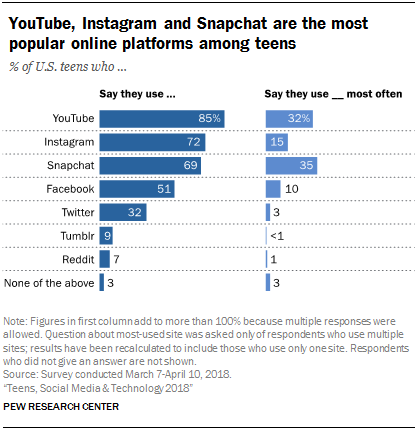Archive of ‘social media’ category
Standom
October 17, 20195:00 AM ET
https://www.npr.org/2019/10/07/767903704/the-2010s-social-media-and-the-birth-of-stan-culture
a small social phenomenon known as “standom.”
While some say the term is a combination of “fan” and “stalker,” “stan” was first coined in 2000 when Eminem dropped a twisted allegory in a song called “Stan,” about a man who was pushed to the edge when his idol wouldn’t answer his fan mail.
The most avid fan bases often have their own labels. Lady Gaga has her Little Monsters. Justin Bieber fans are Beliebers. Nicki Minaj has the Barbz. Beyonce has the BeyHive. And, if motivated enough, stans that congregate on social media actually can change the trajectory of their artist’s path — and the life of anyone who stands in the way.
most popular programming languages
++++++++++
more on coding in this IMS blog
https://blog.stcloudstate.edu/ims?s=coding
On Fire: The Burning Case for a Green New Deal
The Inconvenient Truth: Fixing Climate Requires Major Economic Change, Naomi Klein Says
October 14, 2019, Robin Young Allison Hagan
https://www.wbur.org/hereandnow/2019/10/14/climate-change-naomi-klein-on-fire
In her new book “On Fire: The Burning Case for a Green New Deal,” Klein writes that allegiance to capitalism is at the heart of climate denial.
social media for good
9 ways real students use social media for good
Michael Niehoff October 2, 2019
https://www.iste.org/explore/Digital-citizenship/9-ways-real-students-use-social-media-for-good
1. Sharing tools and resources.
2. Gathering survey data.
3. Collaborating with peers.
4. Participating in group work.
5. Communicating with teachers.
6. Researching careers.
7. Meeting with mentors and experts.
8. Showcasing student work.
9. Creating digital portfolios.
+++++++++++++
more about social media in education in this IMS blog
https://blog.stcloudstate.edu/ims?s=social+media+education
digitally native need computer help
The Smartphone Generation Needs Computer Help
Young people may be expert social-media and smartphone users, but many lack the digital skills they need for today’s jobs. How can we set them up for success?
https://www.theatlantic.com/sponsored/grow-google-2019/smartphone-generation-computer-help/3127/
Kenneth Cole’s classroom at the Boys & Girls Club of Dane County, located on a quiet residential street in Madison, Wisconsin.
The classes Cole teaches use Grow with Google’s Applied Digital Skills online curriculum.
One day he may lead Club members in a lesson on building digital resumes that can be customized quickly and make job-seeking easier when applying online. Another day they may create a blog. On this particular day, they drew up a budget for an upcoming event using a spreadsheet. For kids who are often glued to their smartphones, these types of digital tasks, surprisingly, can be new experiences.
The vast majority of young Americans have access to a smartphone, and nearly half say they are online “almost constantly.”

But although smartphones can be powerful learning tools when applied productively, these reports of hyperconnectivity and technological proficiency mask a deeper paucity of digital skills. This often-overlooked phenomenon is limiting some young people’s ability—particularly those in rural and low-income communities—to succeed in school and the workplace, where digital skills are increasingly required to collaborate effectively and complete everyday tasks.
According to a survey by Pew Research Center, only 17 percent of Americans are “digitally ready”—that is, confident using digital tools for learning. Meanwhile, in a separate study, American millennials ranked last among a group of their international peers when it came to “problem-solving in technology-rich environments,” such as sending and saving digital information
teach his sophomore pupils the technology skills they need in the workplace, as well as soft skills like teamwork.
+++++++++++++++++++++
more on digitally native in this IMS blog
https://blog.stcloudstate.edu/ims?s=digitally+native
more on millennials in this IMS blog
https://blog.stcloudstate.edu/ims?s=millennials
Instagram AI and cyberbullying
https://www.npr.org/2019/10/03/766507832/instagram-now-lets-you-control-your-bullys-comments
Instagram announced a new anti-bullying feature called Restrict.
Fifty-nine percent of American teens have been bullied or harassed online, according to a 2018 survey by the Pew Research Center. Instagram is one of the most popular social media networks among teenagers and a likely place for teens to be bullied.
In a recent study, conducted by the investment bank Piper Jaffray, Instagram is the second most popular social media platform among teenagers. Thirty-five percent of teens surveyed said that Instagram is their favorite social media platform, compared with 41% who preferred Snapchat.
++++++++++++
more on cyberbullying in this IMS blog
https://blog.stcloudstate.edu/ims?s=cyberbullying
social media and first gen students
+++++++++|
more on social media and students in this IMS blog
https://blog.stcloudstate.edu/ims?s=social+media+students
Endgame for LinkedIn
The Endgame for LinkedIn Is Coming
https://medium.com/@lancengym/the-endgame-for-linkedin-is-coming-31d4a8b2a76
LinkedIn had — and still has — multiple branded apps: Job Search, SlideShare, Learning, Recruiter, Sales Navigator and something call ‘Elevate”, which purports to “build your reputation by sharing smart content”. A news and publishing app called Pulse was integrated into the main app in May 2017.
The idea of selling relevant services to your user base is good, but not if you can’t do it well.
LinkedIn’s employees were actually using G suite — the whole bag: Gmail, Calendar, Drive, Hangouts, Docs, Sheets… — before the Microsoft acquisition.
+++++++++++
more on LInkedIn in this IMS blog
https://blog.stcloudstate.edu/ims?s=linkedin
high trust vs low trust societies
one cost of rampant fake reviews, fake accounts, fake views, & fake clicks –> the internet is increasingly becoming a low-trust environment, where an assumption of pervasive fraud is built into the way many things functionhttps://t.co/keOZUYiARL @zeynep pic.twitter.com/rOCPqnQU5y
— Rachel Thomas (@math_rachel) September 22, 2019
